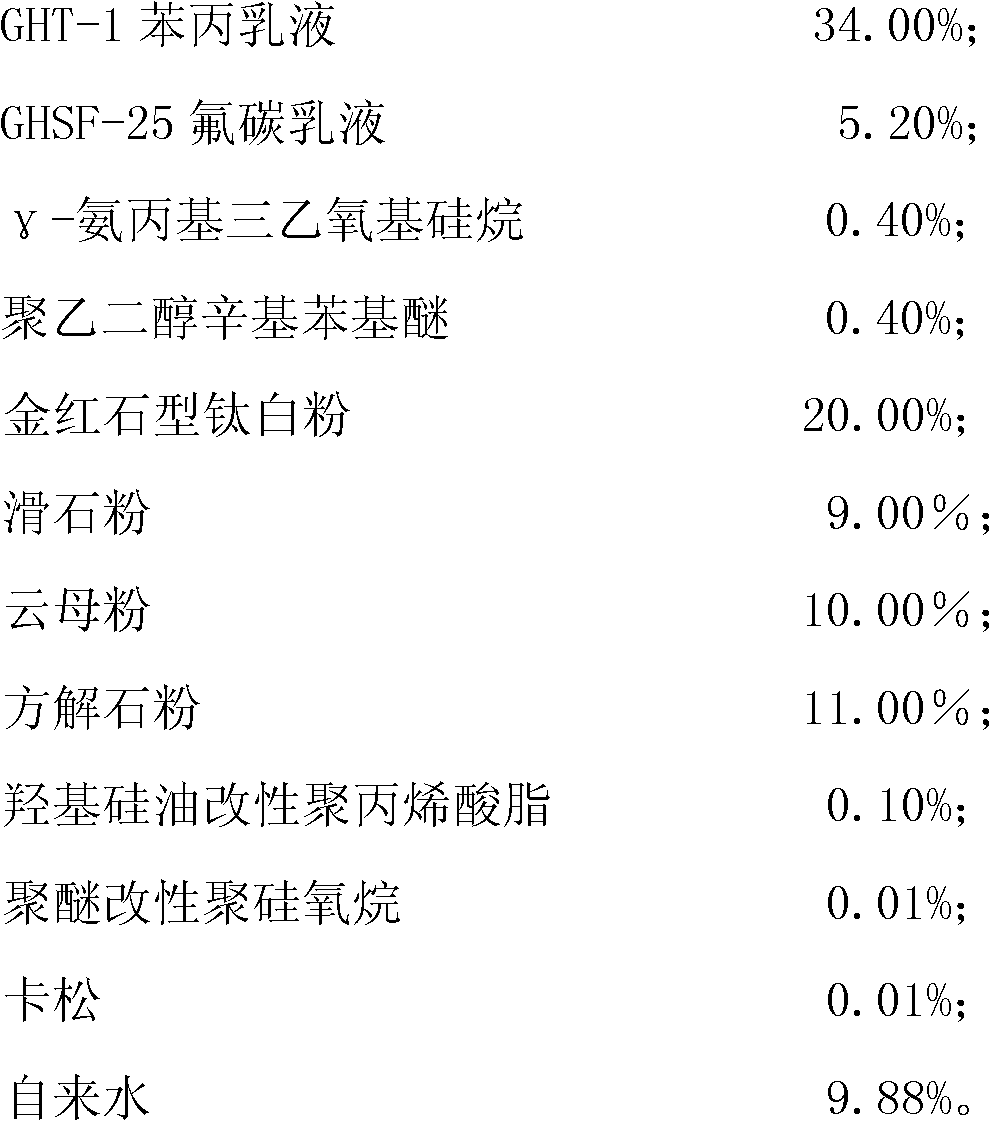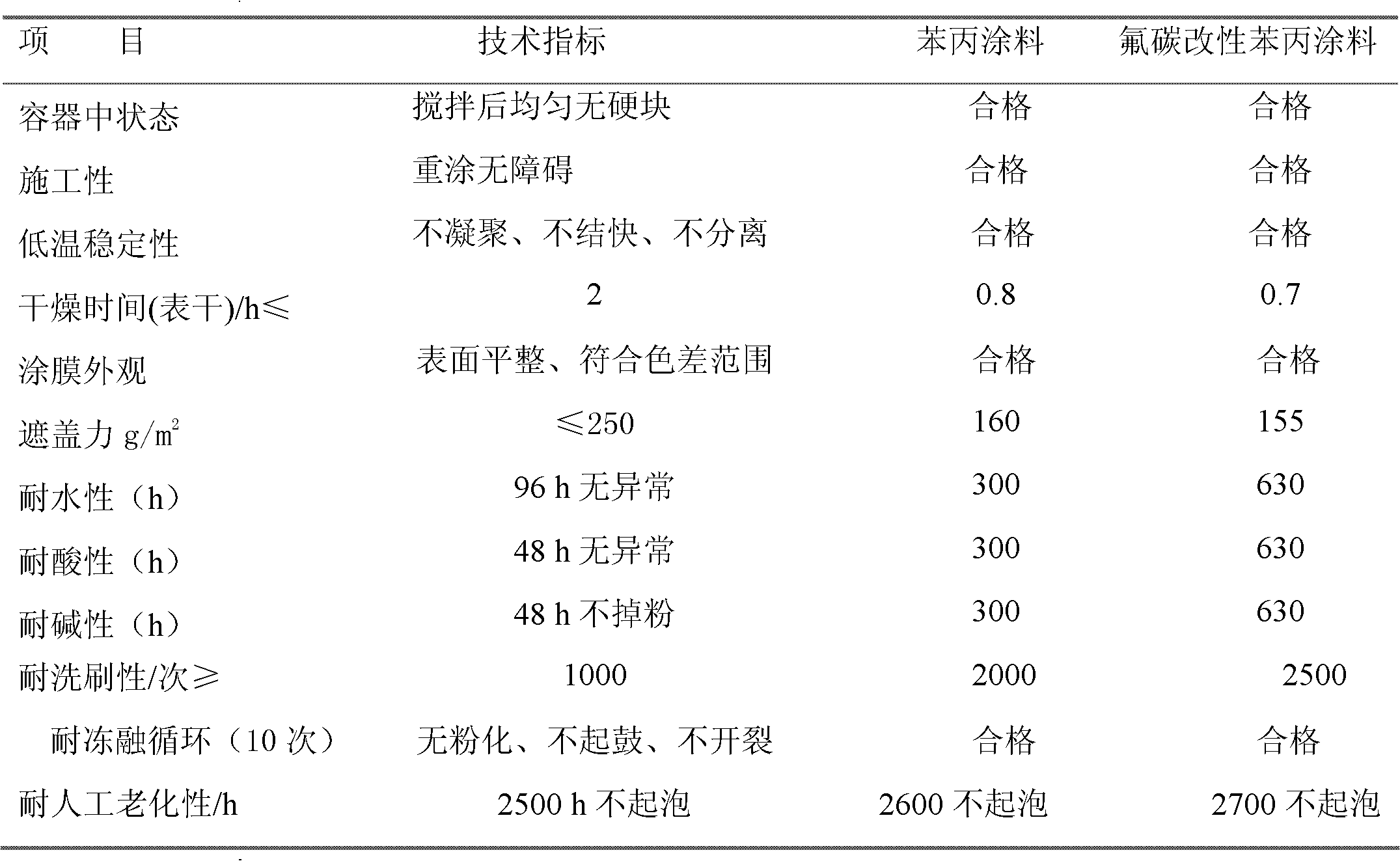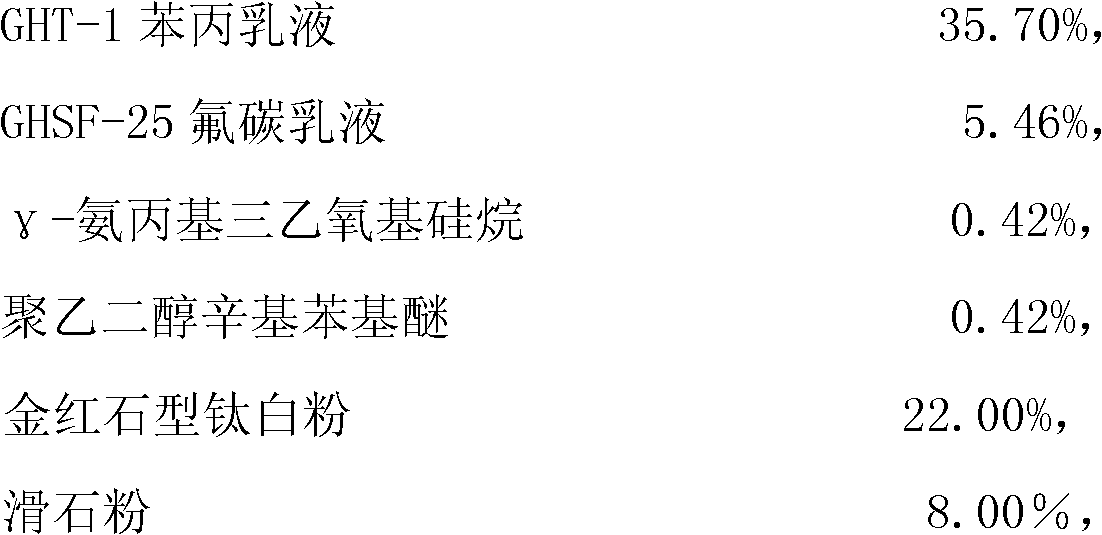Fluorocarbon modified styrene-acrylic coating, and preparation method thereof
A technology of fluorocarbon modification and styrene-acrylic, which is applied in the direction of anti-corrosion coatings and coatings, and can solve the problems of high weather resistance, high chemical corrosion resistance, water resistance, scrub resistance and poor artificial aging resistance
- Summary
- Abstract
- Description
- Claims
- Application Information
AI Technical Summary
Problems solved by technology
Method used
Image
Examples
Embodiment 1
[0016] 1. Formula according to mass percentage
[0017]
[0018] 2. Preparation method
[0019] Step 1. Add GHT-1 styrene-acrylic emulsion into a four-necked bottle, stir and heat up to 73℃, slowly add GHSF-25 fluorocarbon emulsion, and slowly add γ-aminopropyltriethoxysilane, until the addition is complete. -After aminopropyl triethoxy silane, add polyethylene glycol octyl phenyl ether, hydroxy silicone oil modified polyacrylate, polyether modified polysiloxane, and casson respectively, and the temperature is controlled at 76 ℃ to react After half an hour, the temperature was lowered and the material was discharged to obtain a fluorocarbon modified styrene-acrylic emulsion.
[0020] Step 2. Add water to the mixing tank, start the agitator, add rutile titanium dioxide and stir evenly; then add the modified fluorocarbon modified styrene-acrylic emulsion in step 1 and stir evenly, add talc powder, mica powder, and calcite respectively Stir the powder uniformly; and obtain the fluoroc...
Embodiment 2
[0026] 1. Formula according to mass percentage
[0027]
[0028]
[0029] 2. Preparation method
[0030] Step 1. Add GHT-1 styrene-acrylic emulsion into a four-necked flask, stir and heat up to 74℃, slowly add GHSF-25 fluorocarbon emulsion, and slowly add γ-aminopropyltriethoxysilane, until the addition is complete. -After aminopropyl triethoxy silane, add polyethylene glycol octyl phenyl ether, hydroxy silicone oil modified polyacrylate, polyether modified polysiloxane, and casson respectively, and the temperature is controlled at 77 ℃ for reaction After half an hour, the temperature was lowered and the material was discharged to obtain a fluorocarbon modified styrene-acrylic emulsion.
[0031] Step 2. Add water to the mixing tank, start the agitator, add rutile titanium dioxide and stir evenly; then add the modified fluorocarbon modified styrene-acrylic emulsion in step 1 and stir evenly, add talc powder, mica powder, and calcite respectively Stir the powder uniformly; and obtain...
Embodiment 3
[0037] 1. Formula according to mass percentage
[0038]
[0039] 2. Preparation method
[0040] Step 1. Add GHT-1 styrene-acrylic emulsion into a four-necked bottle, stir and heat up to 75℃, slowly add GHSF-25 fluorocarbon emulsion, and slowly add γ-aminopropyltriethoxysilane, until the addition is complete. -After aminopropyl triethoxy silane, add polyethylene glycol octyl phenyl ether, hydroxy silicone oil modified polyacrylate, polyether modified polysiloxane, and casson, and the temperature is controlled at 78 ℃ for reaction After half an hour, the temperature was lowered and the material was discharged to obtain a fluorocarbon modified styrene-acrylic emulsion.
[0041] Step 2. Add water to the mixing tank, start the agitator, add rutile titanium dioxide and stir evenly; then add the modified fluorocarbon modified styrene-acrylic emulsion in step 1 and stir evenly, add talc powder, mica powder, and calcite respectively Stir the powder uniformly; and obtain the fluorocarbon mod...
PUM
 Login to View More
Login to View More Abstract
Description
Claims
Application Information
 Login to View More
Login to View More - R&D
- Intellectual Property
- Life Sciences
- Materials
- Tech Scout
- Unparalleled Data Quality
- Higher Quality Content
- 60% Fewer Hallucinations
Browse by: Latest US Patents, China's latest patents, Technical Efficacy Thesaurus, Application Domain, Technology Topic, Popular Technical Reports.
© 2025 PatSnap. All rights reserved.Legal|Privacy policy|Modern Slavery Act Transparency Statement|Sitemap|About US| Contact US: help@patsnap.com



